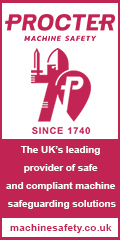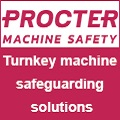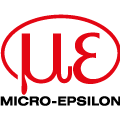
Posted to News on 27th Jan 2022, 08:57
Leuze safety solution for access guarding on machinery
Automatic restart contributes to increased system efficiency on pallet magazines

Manufacturers and operators of machines and systems must comply with legal regulations. Applicable to manufacturers are, among other things, the Product Safety Act – for operating companies, the Ordinance on Industrial Safety and Health. Standards play another important role, points out Leuze. “They describe requirements and provide support in ensuring safety at machines and systems. These are, however, not legally binding in Europe.”
For manufacturers or operators of machines or systems, type C standards are especially relevant. These are machine-specific safety standards. Among these are EN 415-4 ‘Safety of packaging machines – Part 4: Palletizers and depalletizers and associated equipment’. The content of the standard from 1997 was significantly revised.
In the forthcoming version of the standard, new requirements are placed on manufacturers and operating companies. This also affects the access guarding of pallet magazines with automatic restart.
Traditional concept with external induction loops
Up to now, many material transfer stations with automatic restart were safeguarded as follows: electro-sensitive protective equipment (ESPE) secured the access point – if the ESPE is interrupted, the machine and conveyor are stopped. To avoid needing to restart the stopped machine after loading by a corridor supply vehicle, such as a forklift truck, two induction loops are used as muting signals.
These are located in the floor in front of the ESPE. When the forklift moves over the induction loops, the electro-sensitive protective equipment is temporarily bridged.
This solution no longer corresponds to the current state of safety technology: The system often ends in a single-channel evaluation logic; as a result, the safety performance is no longer adequate for the given application under certain circumstances. A new type of access guarding for a pallet magazine aims to prevent the entry of persons but simultaneously allow pallets to enter by means of a forklift truck.
Compliance with standards through sequence monitoring
Manufacturers and operating companies can now make use of a new solution that is described in the future version of standard EN 415-4. This thereby corresponds to the current state of the art. Two induction loops are also used for this type of access guarding on pallet magazines. The difference to traditional concepts: Both of the induction loops are not located in front of the danger zone. Instead, one is located outside of the danger zone and the second is located behind the electro-sensitive protective equipment – ie, within the danger zone.
The ESPE – the optoelectronic protective device – also remains at the previous position. As before, it separates the traffic zone and danger zone. In addition, there is also a safety system that monitors a defined sequence of signals and initiates the automatic restart.
Various possibilities for safeguarding areas of systems
For this solution, the following technical framework conditions must be implemented: the pallet magazine must be safeguarded at the adjacent areas. A person who passes through the ESPE must not be able to enter other areas of the system unnoticed. This can be ensured mechanically, - eg, by means of a height limitation. This allows an empty pallet to pass through, but not a person. Alternatively, a second piece of electro-sensitive protective equipment can be installed to detect the entry of a person into the danger zone.
Another requirement: the outer induction loop over which the forklift truck travels requires sufficient space. This is somewhat larger than the inner loop. In addition, the operating personnel must be instructed because this involves an automatic restart. The driver of the forklift truck is responsible for ensuring that no one gains access to the danger zone by moving alongside the forklift truck.
If, there is still a person in the inner area at this time, the driver must not drive out, as the pallet magazine will otherwise be started. Alternatively, this risk can also be eliminated by means a safeguard that provides stepping behind protection.
Step-by-step to more safety
This type of access guarding functions along a defined process. Working in the background is a safety system that monitors precisely this process flow. Only once the sequence has been concluded does the system initiate the automatic restart of the machine. This process is also described in revised standard EN 415-4:
- The forklift truck arrives, the machine is in operation and the electro-sensitive protective equipment is active
- The forklift travels over the outer induction loop and is thereby detected by the system. The pallet magazine continues to run
- The ESPE is interrupted by the forklift truck. The pallet magazine is stopped. This also applies if a person passes by the ESPE
- The forklift truck continues to move and is located within all sensors: over the outer and inner induction loops and in the protective field of the interrupted ESPE
- The forklift deposits the pallet(s) and travels in reverse. This first frees the inner induction loop and then the ESPE
- The forklift exits the outer induction loop. The sequence is concluded and automatic restart of the pallet magazine is initiated.
In summary, this means: If the presence of a forklift truck is detected by the induction loops and if the forklift then correctly executes the specified process sequence, the safety system initiates the automatic restart of the work process.
Performance level d
With this concept, operating companies benefit from a standards-compliant safety solution corresponds to the current state of the art, states Leuze. “The requirements of EN 415-4 ‘Safety of packaging machines – Part 4: Palletizers and depalletizers and associated equipment’ are thereby satisfied. The system is designed for performance level d, the second-highest safety level. Thanks to the automatic restart of the machine without manual operator interventions, the packaging system can be optimally utilised.”
In addition to increased reliability, the advantages also include optimum protection against manipulation: the sequence- and time-monitored process contributes to high protection against bypassing. Furthermore, the system can easily be integrated in the safety circuit of the primary control and service costs remain minimal. Another plus is the flexible usability: The solution is suitable for both palletisersm as well as for depalletisers, and offers freedom for transport materials to the left and right. Thanks to scalability, the safety system can be adapted to various applications through the use of appropriate components.
Ready-to-use
Leuze offers the described safety solution for access guarding on pallet magazines with automatic restart as a complete package that has been tested and validated with respect to safety with the following components, it states:
- Induction-loop set with evaluation unit
- MLC 500 safety light curtain, with device columns for floor mounting
- MSI 400 safety control, programmable and with induction loop controller
- Leuze safety program
- 2-channel safety output
- Acknowledgement box as electromechanical reset apparatus.
“The reset apparatus is used, if a sequence is not correctly completed. Or a person interrupts the electro-sensitive protective equipment. The button is used to confirm to the system that the process can be correctly restarted and that persons are no longer located in the danger zone.
“As a ready-to-use system, the solution from the Sensor People at Leuze can be used immediately after installation.”
Want the latest machine building news straight to your inbox? Become a MachineBuilding member for free today >>
1B Fenice Court
Phoenix Park
Eaton Socon
PE19 8EW
UNITED KINGDOM
+44 (0)1480 408500

















